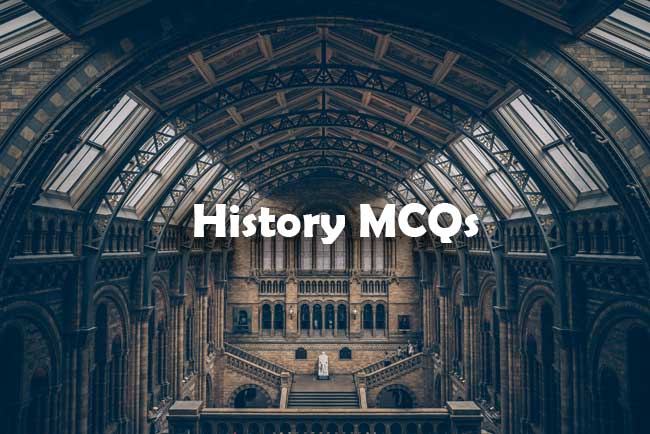SSC CGL History Questions and Answers
Aspirants can find the SSC CGL History Previous Year Question Paper with answers here. Staff Selection Commission CGL History Question Paper are available here. The Candidate who is appearing for Staff Selection Commission CGL can download the History Paper from the link given.

Also, refer the SSC Combined Graduate Level Examination History Syllabus and Test Patter from the link given. Applicants can download the History Syllabus Pdf for free of cost from the link. However, hope our history material will help you in your preparation.
Furthermore, check the Updated Staff Selection Commission Combined Graduate Level Examination History Syllabus from the link below. Also, download the SSC Combined Graduate Level Examination History Syllabus Pdf. The applied candidates can also allow downloading the SSC CGL Exam History Model Question Papers from our website.
Questions and Answers on History for SSC CGL Exam
1. Which of the following sites has not yielded any evidence related to the Indo-Roman trade ?
(A) Ter
(B) Junnar
(C) Adam
(D) Morgaon
2. Which of the following is not the Prenatal samskara ?
(A) Garbhadhana
(B) Pumsavana
(C) Karnavedha
(D) Simantonnayana
3. Which of the following compositions ascertains that Panini and Vararuchi were contemporaries of the Nandas ?
(A) Bruhatkatha
(B) Gathasaptasati
(C) Tolkapiyam
(D) Mrichhakatikam
4. In 326 B.C. when Alexander invaded India, Magadha was ruled by…………………………..
(A) Chandragupta Maurya
(B) Mahapadma Nanda
(C) Dhana Nanda
(D) Udayin
5. According to Megasthenes, the Pandya Kingdom was famous for………………………..
(A) Silk
(B) Bronze
(C) Weapons
(D) Pearls
6. The trade with Barigaza flourished under the control of Western Kshatrapa named……………………..
(A) Nahapana
(B) Rudradamana
(C) Jivadamana
(D) Rudrasimha II
7. Which of the following inscriptions mention the repairing work of Sudarshan reservoir ?
(A) Hathigumpha inscription of Kharavela
(B) Nashik inscription of Nahapana
(C) Junagadh inscription of Rudradaman I
(D) Bhitari Pillar inscription of Skandagupta
8. Which of following Gupta kings had issued copper coins ?
(A) Chandragupta I
(B) Kumaragupta I
(C) Shrigupta
(D) Ghatotkachgupta
9. Which of the following Gupta kings had issued ‘Ashvamedh’ type of gold coin ?
(A) Chandragupta I
(B) Kumaragupta I
(C) Kumaragupta II
(D) Ramagupta
10. Brahmatayam in Sangam literature refers to……………………….
(A) Most sacred place
(B) Group of invited Brahmin priests
(C) Gift of revenue free villages to Brahmin priests
(D) Entire sequence of ritual arranged for a particular occasion
11. Which of the following the copper plates throws light on the administrative measures taken during drought ?
(A) Sohgaura
(B) Chinchani
(C) Shankarpur
(D) Mandhal
12. ‘Sahini’ were……………………………..
(A) The men in charge of entertainers
(B) The men in charge of production unit
(C) The men in charge of royal household
(D) The men in charge of Cavalry
13. During Ancient Indian times, the title ‘Kaisar’ was taken mainly by the following ruling family :
(A) Maurya
(B) Satavahana
(C) Kanishka
(D) Gupta
14. Which of the following Ancient Indian mathematicians composed Shulba Sutra, the text in which basic concepts of mathematics are discussed ?
(A) Baudhayana
(B) Aryabhatta
(C) Brahmagupta
(D) Varahmihir
15. During Satavahana times the terms, Katak and Skandhawar were used in the context of………………………
(A) Fertile land
(B) Disaster
(C) Army base
(D) Market place
16. The famous inscription of Vasishtiputra Pulumavi, in which he explains that Queen Gotami Balasiri, mother of Gotamiputra, caused the built a cave for (Buddhist) Samgha, is located at……………………
(A) Aurangabad
(B) Nashik
(C) Junnar
(D) Paithan
17. A group of 5 Monolithic rockcutshrines at Mahabalipuram were excavated during the rule of the Pallava King…………………………
(A) Simhavishnu
(B) Mahendravarman I
(C) Narasimhavarman I
(D) Nandivarman II
18. …………………… is not an example of the temple site of the Vikatakas.
(A) Mandhal
(B) Hamalapuri
(C) Ramtek
(D) Nagara
19. The Sthanu Ravi copper plate inscriptions record an agreement between merchants of the Malabar coast and some Christian merchants from…………………………….
(A) Venice
(B) The Persian Gulf region
(C) The Black Sea region
(D) The Coromandel coast
20. The name of the famous Buddhist monk mentioned in the inscription of Ajanta Cave No. 24, is
(A) Anand
(B) Sthavirachal
(C) Ashvaghosh
(D) Dhammapal
|
More History Questions for Preparation
|
|
| UPSC | TNPSC |
| GPSC | WBCS |
| NDA | SSC CHSL |
| DSSB | SSC CGL |
| AFCAT | MTS |
| RRB NTPC | MPSC |
| MPPSC | CDS |
| BPSC | |
21. The official named Uparakshita in the Satavahana adimistration, was in charge of…………………………..
(A) Espionage
(B) Currency system
(C) Building caves
(D) Finance and accounts
22. Damras was the term used for………….
(A) Feudal lords in early Medieval Kashmir
(B) Mints in early Medieval Kashmir
(C) Traders in early Medieval Kashmir
(D) Beggars in early Medieval Kashmir
23. Who of the following established Vakataka rule ?
(A) Vindhyashakti
(B) Rudrasen I
(C) Pravarsen I
(D) Pruthvisen I
24. Which of the following Rashtrakuta Kings established his capital at Manyakhet ?
(A) Dantidurg
(B) Amoghvarsh I
(C) Krishna I
(D) Govind II
25. Which of the following temples is not an example of the Chola temple architecture ?
(A) Brahmapurishvara Temple, Pullamangai
(B) Kailasanatha Temple, Tirupattur
(C) Nageshvaraswami Temple, Kumbhakonam
(D) Airavateshvara Temple Darasuram
26. Which of the following temple styles flourished during the rule of the Paramaras ?
(A) Dravida
(B) Vesara
(C) Hemadapanti
(D) Bhumija
27. Warangal fort was defended by two walls, the outer made of……………… and the inner of………………….
(A) Earth and granite
(B) Brick and stone
(C) Earth and wood
(D) Basalt and granite
28. The Yadavas of Devgiri had issued gold coins popularly known as………
(A) Padmatankas
(B) Dinar
(C) Karshapana
(D) Gadhiya
29. The first expedition of Muhammad of Ghur was directed against………….
(A) Multan
(B) Sindh
(C) Punjab
(D) Gujarat
30. In which of the following works of Amir Khusrau do we get a description of siege implements ?
(A) Nuh Siphir
(B) Khazain-ul-Futuh
(C) Tughlaq Nama
(D) Tarikh-i-Alai
31. In the decisive battle of Amroha, in which the Mongols were defeated, who led Alauddin’s forces ?
(A) Malik Nayak
(B) Qutlugh Khan
(C) Zafar Khan
(D) Ali Beg
32. Which class was hit hard by Alauddin’s Measures ?
(A) Peasants
(B) Soldiers
(C) Muqaddams and traders
(D) Nobility
33. When was the city of Burhanpur founded and by whom ?
(A) Malik Ahmad in 1380
(B) Nasir Khan in 1399
(C) Malik Muhammad in 1400
(D) Sikandar Lodi in 1520
34. According to which medieval source were elephants to be found in the Rajpipla forests of Gujarat ?
(A) Ibn Batuta
(B) Abdul Hamid Lahori
(C) Abul Fazl
(D) Abbas Sarwani
35. In the year 1335, which short lived Sultanate was established in India ?
(A) Faruqi
(B) Madurai
(C) Arcot
(D) Tiruchirapalli
36. Athanasius Nikitin was a…………..traveller.
(A) Russian
(B) Italian
(C) Portuguese
(D) Spanish
37. During the period of Muhammad bin Tughlaq, the office of the diwan-imazalim handled………………………
(A) Cases concerning revenue adjustment
(B) Cases of madad-i-ma’ash grants
(C) Cases involving the bureaucracy
(D) The actual collection of revenue
38. Which of the following Sultans sent an embassy to the Ottoman Sultan Suleiman ?
(A) Burhan Nizam Shah of Ahmadnagar
(B) Sultan Bahadur Shah of Gujarat
(C) Sultan Ali Adil Shah of Bijapur
(D) Sultan Yusuf Quli Shah of Golconda
39. To whom were the titles asvapati and gajapati applied in the sources of the Deccan and the south ?
(A) Vijayanagar rulers and the Ganga kings of Odisha
(B) Chalukyas and the Shilaharas
(C) Chola rulers and the Pandya rulers of Madurai
(D) Vijayanagar rulers and the Bahmani Sultans
40. What is meant by the term sthaladayam found in Vijayanagar period inscriptions ?
(A) Tax on grain
(B) A form of forced labour
(C) Transit duty
(D) Tax on plough oxen
| Ancient India | Modern India |
| Medieval India | World History |
41. Which Mughal Prince got the Bijapur and Golconda to sign the Deed of Submission ?
(A) Khurram
(B) Salim
(C) Dara Shikoh
(D) Jalaluddin
42. According to the 17th century text Vyavaharmayukha, watan land was to be considered…………………………
(A) Private property
(B) Ritual and traditional rights in the village
(C) Inherited and communal property
(D) Assignable land
43. What was katraparcha ?
(A) A tax on metal
(B) A tax on paper
(C) A tax on cloth
(D) A tax on looms
44. The kaniyatchi of Chola and Vijayanagar period of South India were………………………..
(A) Upper castes associated with temple management
(B) Bhakti saints
(C) Weavers
(D) Dominant landed classes
45. The final surrender of the Mewar Rana took place :
(A) At the beginning of Jahangir’s reign
(B) Towards the end of Akbar’s reign
(C) Towards the end of Jahangir’s reign
(D) During the period of Shah Jahan’s governorship of Rajasthan
46. What are khasra documents ?
(A) Documents giving details of land owned by peasants
(B) Documents that give the prices of indigo and sugarcane
(C) Documents about customs collected at Surat port
(D) Documents of the nagarsheths of Ahmedabad
47. The earliest reference to the term balutedar is found in the………………
(A) Jnyaneshwari
(B) Seeta Swayamvar
(C) Pune Peth Kaifiyat
(D) Radha-madhav Vilasa champu
48. The Bundelas began to come to prominence after :
(A) The establishment of a capital at Orchcha
(B) The murder of Abul Fazl
(C) The attack on Orchcha by Shah Jahan
(D) The conquest of Malwa by Akbar
49. The Lekhapaddhati is a text from ……………………………
(A) Karnataka
(B) Gujarat
(C) Tamil Nadu
(D) The Doab region
50. Which two political institutions are regarded by historians as the ‘backbone of the Vijayanagar Empire ?
(A) The nayankara and ayagar system
(B) The ayagar system and the Ainnurruvar
(C) The nayankara system and the temple
(D) The temple and the ayagar system


